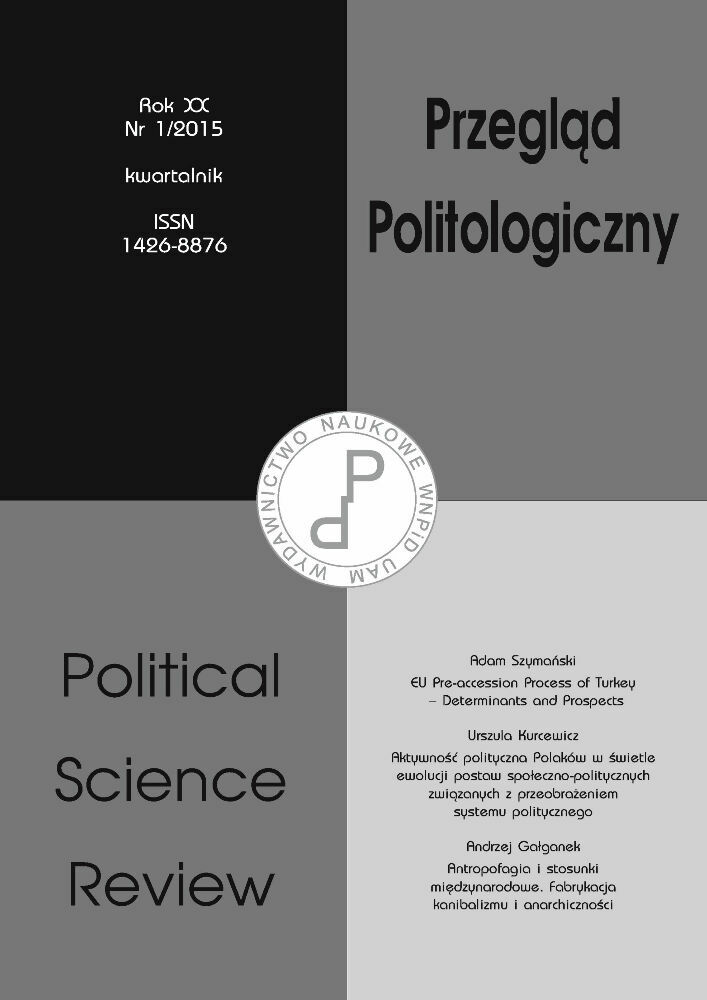Abstrakt
Artykuł jest próbą odpowiedzi na pytanie o wpływ modelu organizacyjnego Investigative Reporters and Editors na powstające od kilku dekad na całym świecie stowarzyszenia dziennikarzy śledczych. Autor omawia rozwój struktur zrzeszających reporterów dochodzeniowych w różnych państwach, w szczególności przyjętych przez nie form działania oraz celów. Rosnąca liczba oraz globalny charakter tego zjawiska prowadzi do instytucjonalizacji dziennikarstwa śledczego na świecie. Scharakteryzowane zostały w artykule wybrane organizacje, w szczególności te, które zaadaptowały model wypracowany przez IRE. W odniesieniu do pozostałych stowarzyszeń dziennikarskich autor wskazuje na przyczyny odrzucenia formuły wypracowanej przez amerykańskich muckrakerów.
Bibliografia
About, Global Investigative Journalism Network, www.gijn.org, 2.02.2014.
About us, The Fund for Investigative Journalism, http://www.fij.org, 2.07.2008.
Adamczyk W. (2008), Amerykańskie archetypy dziennikarstwa śledczego, Poznań.
Adamczyk W. (2013), „Gatemania” jako przykład tabloidyzacji śledztw dziennikarskich, „Środkowoeuropejskie Studia Polityczne”, nr 1.
Adamczyk W. (2014), Dziennikarstwo śledcze w formule non profit: ryzykowny eksperyment czy naturalna alternatywa? „Przegląd Politologiczny”, nr 2.
Andersson B. G. (2003), The educational role of Grävande Journalister, w: Investigative Journalism in the US and Sweden. Lessons to the low countries, red. D. van Eijk, VVOJ, Amsterdam.
Aucoin L. (2005), The Evolution of American Investigative Journalism, University of Missouri Press.
Baggi G. R. (2011), Nonprofit Investigative Journalism in Europe: Motives, Organisations and Practices, Hamburg.
Coronel S. S. (2012a), Opera, game theory and investigative journalism, w: Business models for watchdog reporting, 29.03.2012, http://watchdog-watcher.com, 18.08.2013.
Coronel S. S. (2012b), Will the nonprofit bubble burst? 1.04.2012, WatchDogWatcher.com, 22.03.2013.
Coronel S. S. (2013), A hundred muckraking centres bloom, 22.01.2013, Global Investigative Reporting, WatchDogWatcher.com, 22.03.2013.
Dorroh J. (2009), Statehouse Exodus, „American Journalism Review”, April/May.
Drew J. (2010), The New Investigators. Nonprofits are breaking new ground. Can they sustain themselves? „Columbia Journalism Review”, May/June.
van Eijk D. ed. (2003), Investigative Journalism in the US and Sweden. Lessons to the low countries, VVOJ Amsterdam.
van Eijk D. (red.) (2005), Investigative Journalism In Europe, VVOJ, Amsterdam.
Feldstein M. (2006), A Muckraking Model. Investigative Reporting Cycles in American History, „The
Harvard International Journal of Press/Politics”, nr 11(2).
Gruen A. (2014), A Brief History of Investigative Journalism, w: Accountability Journalism in the Digital Age Web Appendices, University of Cambridge, Working Papers May.
Houston B. (2008), Beacons of Hope: Investigative Journalism Centers. Training and support for investigative journalists are increasing, and collaborative projects are happening worldwide, Nieman Reports, Spring, vol. 62, nr 1.
Hunter M. (1996), Moment of Truth at IRE, „Columbia Journalism Review”, July/August.
Johnston C. (2009), Welcome to the Jungle: Journalists, meet the all-or-nothing job market, „Columbia Journalism Review”, 22.05.2009.
Kaplan D. E. (2013), Global Investigative Journalism: Strategies for Support. A Report to the Center for International Media Assistance, Second Edition, Washington DC, January 14.
Kirchhoff S. M. (2009), The U.S. Newspaper Industry in Transition, 8.07.2009, Congressional Research Service, 7-5700, www.crs.gov, 9.11.2012.
von Krogh T. (2003), Lessons from Sweden – An Association to learn from, w: Investigative Journalism in the US and Sweden. Lessons to the low countries, red. D. van Eijk, VVOJ, Amsterdam.
Lewis C. (2007), The Nonprofit Road, „Columbia Journalism Review”, September.
Lewis C. (2007a), The Growing Importance of Nonprofit Journalism, Joan Shorenstein Center on the Press, Politics and Public Policy: 2-51.
Lewis C. (2009), Great Expectations. An Investigative News is born. Now What? „Columbia Journalism Review”, October.
Malkawi K. (2009), Investigative reporting ‘profitable’, experts say, „McClatchy Tribune Business News”, 23.11.2009.
Møller L., Jackson J. (2002), Journalistic Legwork that Tumbled a President. A Case Study and Guide for Investigative Journalists, World Bank Institute, Washington DC, 1.01.2002, www.pcij_estrada.pdf, 12.01.2015.
Müller S., Gusy C. (2010), Background information report. Media policies and regulatory practices in selected set of European countries, the EU and the Council of Europe: The case of Germany, Universität Bielefeld, October.
Njotea R. (2012), News-Fresh mapping of non-profit Investigative Journalism in Europe, 26.03.2012, http://www.journalismfund.eu, 19.01.2015.
Our History, The Investigative Reporters and Editors, http://www.ire.org, 20.06.2008.
Periodistas de Investigación, http://www.investigacion.org.mx, 12.02.2015.
Rodrigues F. (2008), Global Efforts at Investigative Reporting, Nieman Reports Spring, Global Watchdogs March 15.
Schiffrin A. (2014), Why we’re living in the golden age of investigative journalism, 31.08.2014, http://www.salon.com, 15.01.2015.
Shapiro B. (red.) (2003), Shaking the Foundations. 200 Years of Investigative Journalism in America, New York.
Soares M. (2003), Tim Lopes’s Murder Sows a Seed, „Global Journalist”, 3rd Quarter.
Stepp C. S. (2006), Is investigative Reporting Here to Stay? „American Journalism Review”, December/January.
Sterling C. H. (2009), Encyclopedia of Journalism, Sage Publications. U.S. newsroom employment declines, American Society of News Editors, April 16, 2009. http://www.asne.org/, 9.11.2012.
Walton M. (2010), Investigative Shortfall, „American Journalism Review”, September.
Who killed the newspaper? The most useful bit of the media is disappearing. A cause for concern, but not for panic, 24.08.2006, „The Economist”.
